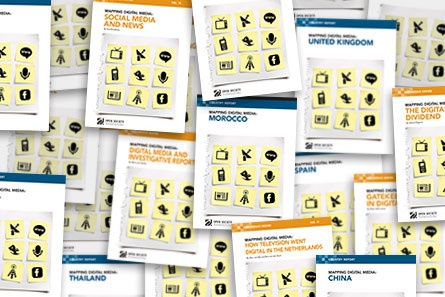

Journalism and Digital Times: Wider Reach and Sloppy Reporting
 Editor’s Note: GIJN is pleased to present the second of a three-part series excerpted from Digital Journalism: Making News, Breaking News, a new report by the Open Society Foundation’s Independent Journalism and Information programs. The report summarizes the findings of OSF’s Mapping Digital Media project, the most extensive investigation of today’s media landscapes by any non-governmental organization, with more than 50 country reports since 2011. Its findings on the impact of digitization on media freedom and access to quality news are essential reading. The story below is from Ying Chan’s chapter, Journalism and Digital Times: Between Wider Reach and Sloppy Reporting.
Editor’s Note: GIJN is pleased to present the second of a three-part series excerpted from Digital Journalism: Making News, Breaking News, a new report by the Open Society Foundation’s Independent Journalism and Information programs. The report summarizes the findings of OSF’s Mapping Digital Media project, the most extensive investigation of today’s media landscapes by any non-governmental organization, with more than 50 country reports since 2011. Its findings on the impact of digitization on media freedom and access to quality news are essential reading. The story below is from Ying Chan’s chapter, Journalism and Digital Times: Between Wider Reach and Sloppy Reporting.
Digitization is one of the primary driving forces behind recent changes in journalism, including news values, professional ethics, workflows, working conditions, and newsroom management. The Mapping Digital Media study shows that digital media have not only changed journalism practices in developed countries but have also significantly shaped the way journalists work in emerging markets. Digital media bring opportunities, risks, and challenges to journalism. While digitization facilitates news gathering and dissemination, it does not necessarily foster better journalism. Plagiarism, lack of verification, and other unethical journalistic practices have increased alarmingly in many countries.
Specifically, when it comes to investigative journalism, digitization has created new publishing platforms and dissemination channels for professional journalists and aspiring citizen reporters alike, but in the majority of countries investigative reports do not seem to be having an increased social impact. Some MDM country reports claim that digitization has wrought havoc on investigative journalism.
While digitization provides opportunities for citizen journalists and independent media to conduct their own research and investigation and in turn publish and distribute their reports, in many countries the accountability of such original content created by citizen journalists is questionable.
The emergence of digital media has enabled minority groups to have a voice in the public arena, but it has not shifted the traditional media’s practice of covering sensitive issues in a restricted, biased, or sensational manner.
Almost all candidates in general elections use social media platforms to communicate with voters, but the emergence of new political actors because of digitization is something that has occurred in only a few countries. Digital media have, however, remarkably increased the volume of political discussion and raised the political interest of the general public.
Risks and Opportunities for Good-quality Journalism
Digitization brings new opportunities to journalists in three notable respects: faster news delivery, better access to sources and information, and more interaction with readers. Nearly two-thirds of the 56 countries in the study noted that digitization had quickened news production and delivery cycles, trends that are most remarkable in countries in Asia and in North and South America. In about half of the countries, most of which are emerging economies such as China, Brazil, India, and South Africa, digital media have provided more sources and information to journalists. In almost all the countries digital media enhanced the interaction between the editorial team and readers, making it easier for reporters to learn about customers’ reading habits and interests.
In Germany, for example, digital technology has not only given journalists the possibility of reaching more sources but it also has let them dig into the details of a story to improve their copy. In Canada, meanwhile, digitization has enabled the creation of large databases and archives that allow journalists to retrieve background information much faster than was the case in the analog world. Building stronger relationships with readers and viewers has been one of the biggest benefits that digitization has brought to journalists:
Digital transformations in the newsroom and in use out in the field have enabled journalists to exploit digital media tools to their advantage. By enhancing their ability to retrieve information through search engines and smartphones, locating sources and building relationships with new and old audiences through j-blogs and social networking sites and democratizing the former role of the copy taster, journalists are able to widen their source base and improve their interview questions when under pressure. (For more, see MDM: Canada)
Similar trends are found in Singapore where “the internet has become an important source for news stories, a crucial platform for distributing news, as well as receiving instant feedback from readers.”
However, digitization has also posed challenges and risks to journalistic standards as the news cycle shrinks, and the internet has made it more convenient for journalists to commit plagiarism. In more than half the countries, reporters pay less attention to verifying the facts and sources for their stories. The prevalent use of published materials and rumors in news stories has posed “the most pervasive threats” that digitization has brought to journalism.
In developed countries such as the United States, the United Kingdom, and Finland, as well as developing countries like China, South Africa, Brazil, India, and Egypt, there were declines in original content and increasing copy-and-paste journalism in the news media. An equal number of emerging and developed economies reports noted practices like prevalent plagiarism, violation of copyright law, or quoting without attribution. Such practices span a broad spectrum of countries, ranging from the United States and Canada in North America, and Egypt, Kenya and South Africa in Africa, to Asian countries like China, Japan, India, and Indonesia.
Time pressures and fast-paced journalism have made journalists more prone to mistakes. In Brazil, “the quality of news has been compromised by an editorial workflow that privileges speed over accuracy. The race to deliver news as fast as possible can lead to deficient revision practices and inconsistent fact checking, along with a tendency to reproduce content as it is received—in the format of, for example, press releases—as opposed to properly finding and checking sources.”
In Malaysia, newspaper editors said that plagiarism was very easy online using the copy-and-paste function. According to Yong Soo Heong, editor-in-chief of Bernama, Malaysia’s state-owned news agency: “Previously, some news editors would say ‘Do not read the Bernama ticker tape,’ and come up with an original story first. But we can’t do that now because everyone can read online and search Wikipedia or Google.”
Digitization has also posed a threat in terms of data security and individual privacy. In almost a fifth of the countries, digitization has made the theft of information and the illegal interception of conversations easier. Countries experiencing this include largely Eurasian countries such as Russia, China, and India, and those African countries where there is greater connectivity, such as Kenya and Morocco. In the United States, potential leaks of information pose a bigger threat to good journalism than plagiarism. The United States report cited the State Department cables released by WikiLeaks and observed that “it is clear that the possibilities of involuntary institutional transparency are considerable, and this has forced the journalism profession in the United States to examine how to engage with sources that hold massive caches of data.”
The working conditions for journalists have generally worsened as a result of digitization. As news production has become faster with higher information volumes being generated, journalists are increasingly expected to work longer hours and possess diverse digital skills. Journalists in the digital age not only write articles but also shoot and edit images and videos, and manage social media, all of which increases their workload. In the context of tightening financial resources and increasing competition, journalists’ working conditions have been deteriorating as they are required to work extra hours and assume new roles to accommodate demands that derive from digital news delivery.
Perhaps the biggest role that digitalization plays in journalism lies in news gathering and dissemination rather than in news quality. In France,
The expansion of online news has not substantially enlarged the volume of valuable information, as most content is still based on the same sources as before digitization: press agencies, press conferences, or internal sources of information. It is rather a system of dissemination of the news (the hypermedia system) that has changed, as similar content is now delivered on the main websites, commented on by blogs, and promoted on Twitter and Facebook. (For more, see MDM: France)
Digitization has become a watershed for good and average journalism. One journalist, Bernard Poulet, said that “digitization has the same effects on journalism that globalization has on the middle class,” comparing digitization with the death of the middle class of journalists. Mr Poulet projected that the profession of journalism will split into two distinct groups: a majority of “blue-collar” underpaid journalists, performing routine tasks and “feeding the machine,” and a few high-ranking journalists with great expertise and a unique personal style, whose names might even become brands.
Digital media are likely to trigger changes in media structure in countries where news remains heavily censored. In China, in the last few years many media have been transformed from tools for party propaganda into semi-autonomous, market-oriented media. During this change, the party line has weakened while market influences have been strengthened, solemn news reporting has decreased while human interest stories, entertainment news, and tabloid journalism have abruptly increased. These changes have profoundly influenced the public’s news demands, the media’s news offer, and the role of journalists.
Watchdog Journalism
Digital media have created unprecedented opportunities for investigative journalists, with new publishing platforms and distribution channels. More than 60 percent of the countries have seen a surge in new publishing platforms such as blogs, independent websites, and email groups for investigative journalism. The encouraging trends span the spectrum of countries from emerging economies such as China, India, Kenya, Egypt, Morocco, and Brazil to developed economies such as the United States and France.
However, less than one-third of the countries noted that digital media have helped to expand the social impact of investigative reports. In Asian countries such as China, India, Pakistan, Malaysia, and Thailand, digitization facilitated the production and dissemination of investigative reports and helped them enlarge their social impact. In some European countries, such as Russia and Germany, the impact of investigative journalism in the digital age has been increasing due to digital platforms. In contrast, in several Latin American and Western European countries, the impact of investigative reports on the digital side was limited. These countries include the Netherlands and Spain, and Mexico, Peru, and Argentina.
In India, there are several digital media platforms that publish investigative reports, such as Indiareport.com, Youthcurry.blogspot.com, and Churumuri.wordpress.com. The impact of the investigative reports published on these platforms is amplified by television news channels and social media networks and has resulted in the resignation or arrest of senior government officials and high-profile politicians and corporate executives.
In Pakistan, the proliferation of media outlets has helped to increase the audiences and reach of investigative stories. Thanks also to cross-media ownership, media groups have been able to promote their investigative work across platforms. At the same time, the internet has become the main publication alternative for content that is not published or broadcast by mainstream media outlets owing to pressure from the state, advertisers, and political parties. The reach of these stories is further amplified by social media such as Twitter and Facebook that are widely used by media groups to promote news content. Other online platforms such as YouTube give journalistic content a longer shelf life. Investigative journalism has had a social impact in Pakistan, even though there is a blurring line between leaks, whistleblowing, and real investigative reporting:
Anonymous contributions featuring violent incidents or documenting abuses of power via internet have led to judicial inquiries and prosecutions. In particular, the blog of Malala has drawn the world’s attention to the threat posed by militancy to girls’ education. The attack she survived from Taliban militants led to national and international condemnation and has sparked a global activist movement on behalf of girls’ education. (For more, see MDM:Pakistan)
In Jordan, there has been a “big response by society and the government to investigative journalists’ video evidence.” An investigative piece by the Arab Reporters for Investigative Journalism (ARIJ)1 was picked up by local news websites and subsequently tweeted, re-tweeted, and posted on Facebook. This triggered a flood of intense commentary and helped spark a public debate, which in the end inspired competitors to run their own investigations. For example, the investigation of abuses at private centers for the handicapped spurred public outrage, prompting the king himself to visit the centers and demand punishment for those responsible.
Similar trends are found in Japan where the “internet is a useful information source and study tool for investigative journalists.” In Armenia, as well, where investigative reporting has traditionally been rare, digitization has multiplied the readers of investigative reports. In Argentina, mobile phones have played a remarkable role in disseminating investigative reports: “Digitization, including mobile phones, cameras and the internet, has saved the cost of journalist enquiry.” The positive impact on investigative journalism is also noted in Brazil where “digitization improved the dissemination and effectiveness of investigative reports.”
Even in China, where the government imposes tight control on news media and journalists, investigative reporting is being revamped in the age of the internet:
Social media have become a vanguard for breaking censorship and creating space for traditional media to report stories they could not years ago. More importantly, they are making investigative reporting into a process rather than a product. Twitter-like microblogging as well as conventional blogging have added further possibilities that allow journalists not only to publish what has been investigated, but to turn the investigation into a public conversation and ask for tips. (For more, see MDM: China)
A particular phenomenon in China is microblogging and its massive impact on journalism: “It breaks the boundaries of news organizations, and investigative reporters, even if they are competitors, tend to form a temporary community on microblogs for information-gathering to meet their various needs … The image of the investigative reporter as a lone wolf is no longer correct.”
Digitization has made possible big data and data journalism, which is another approach to promoting government transparency and accountability. In almost all the MDM countries, the internet makes it easier for journalists today to access and compare data. Increasingly digital platforms have been boosting data-driven journalism. Digitization was very often mentioned by journalists interviewed for this project as a driving force behind the creation and use of databases. Data-driven journalism has been developing fast in Western Europe and North America, with Eastern Europe coming up fast behind.
For investigative journalism, the biggest, most unequivocal gain from digitization by far has been the extended access to sources, information, and data. This has happened in approximately 80 percent of the countries in the project.
Meanwhile, digital media have posed new challenges for investigative journalism. The most common problems include hacking websites; reporters and sources being followed, monitored, and threatened; prosecution; the theft of information; difficulties in reaching sources; and the interception of information by the government.
In addition, the fast and huge flow of news has adversely affected investigative journalism. In countries as varied as Japan, Russia, Slovakia, Estonia, and India multiple forms of digital media, increasing numbers of media outlets, fierce media competition, and journalists’ pressure to break news have led to the inclusion of erroneous, misleading, and misinterpreted information in the news. There is unverified or biased coverage even in investigative reports. In Malaysia, journalists’ exaggerated reliance on user- generated content such as Wikipedia led to misreporting. In Moldova there have also been more misleading and misinterpreted data in journalistic stories.
In Canada, although the ways in which digitization has improved or hindered investigative journalism are still unclear, new opportunities are being made available through digital media tools for sources to contact journalists and for journalists to discover new sources. The digitization of huge volumes of information has improved access, particularly access to government documents. Yet digitization has also increased the demand for immediacy in news delivery: the drive to be there, live, on location. Investigative journalism suffers in this context as the news content suffers in quality. The negative impact of time pressure on journalists’ output has been also noted in India:
The frenetic pace, partially set by digitization and partly by competition, has led to mistakes, even blunders. In addition, round- the-clock schedules leave reporters and editors with less time to pursue serious, long-term, in-depth investigations. Apart from a few print publications, mainstream television channels and websites have been unable to pursue investigative journalism seriously. Even though access to information has become easier, few journalists have been trained or take the time to wade through the enormous amount of data available online. (For more, see MDM:India)
A phenomenon that has not been spawned by digitization and that survives in many countries, badly affecting the editorial output and the journalistic profession, is self- censorship. Countries as varied as Nigeria, Nicaragua, Guatemala, and China have continued to experience the bad effects of self-censorship on investigative reporting in particular. In China above all, there have been numerous threats to investigative journalism:
In the digital age, investigative journalism still encountered obstacles from the government, social organizations, and individuals, in the form of state supervision systems and the self-censorship practices of both media and individuals. Professional journalists who publish sensitive stories still face punishment such as loss of status, reduced wages, being fired, or permanent expulsion from the media community. Also, the government has not allowed websites to be set up to host investigations into specialized subjects or themes, such as corruption, human rights, energy and the environment, health and safety. (For more, see MDM:China)
In Japan, “investigative reporting by mainstream mass media still has the most influence and gains the most public attention.” Although there has also been some investigative reporting by independent and eminent individuals, most of them “have reached an advanced age and rarely publish on the internet.”
The findings of the MDM reports are supported by leading journalists and experts. Dick Tofel, president of the American-based nonprofit news organization ProPublica, says that big data along with new ways to tell stories are two key trends shaping the future of investigative journalism. “Investigative journalists can cover new and different kinds of stories using big data sets and digital storytelling. Using data to let people localize national stories is just one important way that investigative journalism is changing for the better.”
Aron Phihofer, associate managing editor of digital strategy at The New York Times, and Francesca Panetta, audio producer at The Guardian, have also noted that “digital doesn’t mean the death of investigative and long form journalism,” citing award- winning projects such as “Snow Fall” and “Firestorm.” Barry Sussman, editor of the Nieman Watchdog Project, agrees that websites have created new multimedia platforms for news organizations to display their investigative pieces. Nonprofit entities and individuals are also given the chance to publish their own investigative work. However, few investigative assignments will be or should be completed online. It is still important to work with actual sources. “Databases, and the computer tools we have to work with, are a terrific resource,” he said, “but there still need to be stories about real people and real people’s lives.”
Reprinted with permission from the Open Society Foundations. The full report can be found here. Note: OSF is a donor to the Global Investigative Journalism Network.
 Ying Chan is founding director of the Journalism and Media Studies Centre at Hong Kong University. She spent 23 years as a journalist in New York City, reporting for the New York Daily News, NBC News, and Chinese-language dailies. Her honors include a Nieman Fellowship at Harvard University, a George Polk Award for journalistic excellence, and an International Press Freedom Award by the Committee to Protect Journalists.
Ying Chan is founding director of the Journalism and Media Studies Centre at Hong Kong University. She spent 23 years as a journalist in New York City, reporting for the New York Daily News, NBC News, and Chinese-language dailies. Her honors include a Nieman Fellowship at Harvard University, a George Polk Award for journalistic excellence, and an International Press Freedom Award by the Committee to Protect Journalists.












